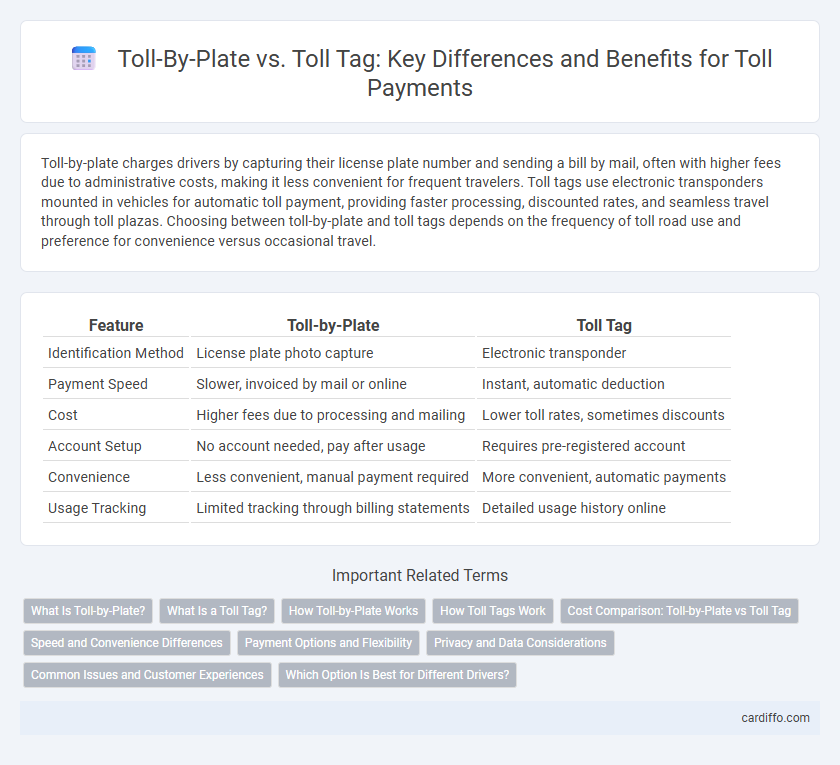Toll-by-plate charges drivers by capturing their license plate number and sending a bill by mail, often with higher fees due to administrative costs, making it less convenient for frequent travelers. Toll tags use electronic transponders mounted in vehicles for automatic toll payment, providing faster processing, discounted rates, and seamless travel through toll plazas. Choosing between toll-by-plate and toll tags depends on the frequency of toll road use and preference for convenience versus occasional travel.
Table of Comparison
| Feature | Toll-by-Plate | Toll Tag |
|---|---|---|
| Identification Method | License plate photo capture | Electronic transponder |
| Payment Speed | Slower, invoiced by mail or online | Instant, automatic deduction |
| Cost | Higher fees due to processing and mailing | Lower toll rates, sometimes discounts |
| Account Setup | No account needed, pay after usage | Requires pre-registered account |
| Convenience | Less convenient, manual payment required | More convenient, automatic payments |
| Usage Tracking | Limited tracking through billing statements | Detailed usage history online |
What Is Toll-by-Plate?
Toll-by-Plate is an electronic toll collection system where cameras capture a vehicle's license plate as it passes through a toll point, automatically billing the registered owner without the need for a physical toll tag. This method eliminates the need for pre-registering or carrying a tag device, making it convenient for infrequent users or visitors. However, toll-by-plate often incurs higher fees compared to using a dedicated toll tag, which offers discounted rates and faster processing through dedicated lanes.
What Is a Toll Tag?
A toll tag is an electronic device affixed to a vehicle's windshield that enables automatic payment at toll plazas, eliminating the need to stop for cash transactions. It uses radio-frequency identification (RFID) technology to communicate with toll sensors, instantly deducting the toll amount from a prepaid account linked to the tag. Compared to toll-by-plate systems, which rely on license plate recognition and invoicing, toll tags provide faster processing times and often offer discounted rates for frequent users.
How Toll-by-Plate Works
Toll-by-plate works by capturing an image of the vehicle's license plate as it passes through a toll point, linking the plate to the registered owner's account or billing address. This system enables toll authorities to send invoices directly to the vehicle owner without requiring a physical toll tag. The convenience of toll-by-plate allows drivers to use toll roads without prior registration, though it often incurs higher fees compared to toll tag payments.
How Toll Tags Work
Toll tags operate using RFID technology that communicates with roadside readers as vehicles pass through toll points, automatically deducting fees from a prepaid account. This contactless system ensures seamless travel by eliminating the need to stop at toll booths, reducing congestion and travel time. Vehicles without toll tags are charged via toll-by-plate, which uses automated license plate recognition, often resulting in higher fees and delayed billing.
Cost Comparison: Toll-by-Plate vs Toll Tag
Toll-by-Plate typically incurs higher costs due to additional administrative fees and invoice processing charges compared to toll tags, which offer discounted toll rates and automatic payments. Toll tags reduce expenses by providing seamless toll collection and avoiding costly mailed bills. Selecting a toll tag over Toll-by-Plate can lead to significant savings for frequent travelers.
Speed and Convenience Differences
Toll-by-plate offers the convenience of automatic billing without requiring a physical tag, but it often results in slower processing times due to manual image capture and invoice mailing. Toll tags enable instant electronic toll collection through a transponder, significantly increasing speed at toll booths and reducing wait times. For frequent drivers, toll tags provide seamless, faster passage compared to the delayed and sometimes less efficient toll-by-plate system.
Payment Options and Flexibility
Toll-by-plate allows drivers to pay tolls using their license plate number, eliminating the need for any physical device, which offers convenience for occasional users but may include additional processing fees. Toll tag systems use electronic transponders linked to prepaid accounts, enabling seamless, automatic toll payments with discounts and faster passage through toll gates. Choosing between these options depends on your travel frequency and preference for upfront convenience versus long-term savings and flexibility.
Privacy and Data Considerations
Toll-by-plate systems capture vehicle images and store license plate data, raising privacy concerns due to potential data sharing with third parties and longer retention periods. Toll tags use encrypted transponders that transmit anonymized data, minimizing the risk of personal information exposure. Users prioritizing privacy often prefer toll tags for their limited data collection and enhanced protection against unauthorized access.
Common Issues and Customer Experiences
Toll-by-plate often leads to higher fees and delayed billing, causing confusion and frustration among customers due to missed payments and fines. Toll tags provide real-time toll deductions, enabling smoother travel and easier account management with clearer transaction records. Many users report fewer billing errors and improved convenience with toll tags compared to the toll-by-plate system.
Which Option Is Best for Different Drivers?
Toll-by-plate is ideal for infrequent drivers or visitors who prefer not to carry a physical device, as it bills based on license plate recognition but usually comes with higher fees. Toll tags offer significant discounts and faster processing for frequent commuters, reducing wait times and simplifying payment through pre-funded accounts. Drivers who prioritize convenience and cost savings typically benefit more from toll tags, while occasional or one-time users may find toll-by-plate more practical despite potentially higher costs.
Toll-by-plate vs toll tag Infographic

 cardiffo.com
cardiffo.com